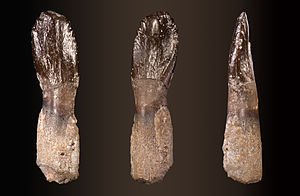Archaeodontosaurus
| Archaeodontosaurus | ||||||||||
|---|---|---|---|---|---|---|---|---|---|---|

Tooth (different views of the same specimen) |
||||||||||
| Temporal occurrence | ||||||||||
| Middle Jurassic ( Bathonium ) | ||||||||||
| 168.3 to 166.1 million years | ||||||||||
| Locations | ||||||||||
| Systematics | ||||||||||
|
||||||||||
| Scientific name | ||||||||||
| Archaeodontosaurus | ||||||||||
| Buffetaut , 2005 | ||||||||||
| Art | ||||||||||
|
||||||||||
Archaeodontosaurus is a genus of dinosaurs and a very original representative of the sauropods . So far only one jawbone ( dental ) with a few teeth is known, which comes from the Middle Jurassic ( Bathonium ) of Madagascar . The teeth were very primitive and resembled those of the forerunners of the sauropods (the " prosauropods "), while the jawbone followed the advanced construction plan typical of sauropods. This combination is very unusual for early sauropods - mostly the reverse combination is found with a prosauropod-like jaw and sauropod-like teeth. Such a reversal of advanced and original features is called mosaic evolution in evolutionary biology . This genus is important for understanding the early evolution of the sauropods and suggests mosaic evolution in various early lines of development of this group. Archaeodontosaurus wasscientifically described in 2005 by the French paleontologist Éric Buffetaut , the only species being Archaeodontosaurus descouensi .
features
The only find consists of a right dentine (the tooth-bearing bone of the lower jaw), which, however, lacks the front and rear ends. The preserved part of the bone measures 18.7 cm in length and has a maximum depth of 6.4 cm. 16 tooth sockets are preserved, but there may have been a few more on the unpreserved ends of the bone. Teeth or tooth fragments were preserved in 8 of these tooth sockets, none of the preserved teeth had yet erupted . Since the upper, inward-facing edge of the dental is poorly preserved, the teeth are partially exposed on the inside.
The dental follows the anatomy typical of sauropods: The depth of this bone increases significantly towards the front, which indicates a deep symphysis (the seam between the two halves of the lower jaw). In addition, the front section of this bone in particular was curved inwards, which suggests that the jaws formed the U-shaped dentition typical of sauropods. In contrast, the jaws of the prosauropods were straight and converged in a V-shape when viewed from above.
The tooth crowns, however, resembled those of the prosauropods more than those of other sauropods. Viewed from the side, they were leaf-shaped and tapered towards the top, while those of other sauropods were mostly spatulate. In addition, the tooth crowns were curved outwards (convex) on the side facing the tongue - those of other sauropods, on the other hand, were curved inwards (concave) and thus spoon-shaped. Furthermore, the tooth crowns of Archaeodontosaurus were sawn with at least 11 large teeth, another original feature. However, like other sauropods , the enamel was folded - in prosauropods it was smooth.
Comparisons and systematics
Comparisons with other very early sauropods are only possible to a very limited extent, as cranial bones are rarely passed on. Jaw bones are known from the early sauropods Kunmingosaurus , Shunosaurus , Chinshakiangosaurus , Tazoudasaurus, and Protognathosaurus . Kunmingosaurus shows a deep lower jaw and spatulate teeth and thus corresponds to later sauropods. Shunosaurus shows laterally flattened teeth that were not spoon-shaped as in later sauropods; the lower jaw wasn't particularly deep. Chinshakiangosaurus resembled Archaeodontosaurus in jaw morphology. The teeth also had a prosauropod-like appearance, but were already somewhat concave on the side facing the tongue. Tazoudasaurus, on the other hand, has spatulate teeth, but slender jaws that resemble those of the prosauropods. The only shape that has a similar combination of features as Archaeodontosaurus is the Chinese Protognathosaurus : In this shape, however, the teeth were more spatulate than Archaeodontosaurus and showed 8 to 10 small teeth.
Since Archaeodontosaurus is only sparsely known, and since comparable fossils are rare in other early sauropods, the systematic position of this genus within the sauropods cannot be determined at present.
Find and naming
The fossil comes from the area around Ambondromamy , a village in the Kamoro Valley southwest of Mahajanga . It comes from the sand and clay stones of the Isalo IIIb Formation , which can be dated to the Bathonian . The name Archaeodontosaurus ( Greek archaios - "old", odous - "tooth", sauros - "lizard") points to the original, prosauropod-like morphology of the teeth. The species name descouensi honors Didier Descouens from Toulouse, who handed the find to the Musée d'Histoire naturelle , the natural history museum in Toulouse, and thus made it accessible to science.
Individual evidence
- ↑ a b c d e f Eric Buffetaut : A new sauropod dinosaur with prosauropod-like teeth from the Middle Jurassic of Madagascar. In: Bulletin de la Société Géologique de France. Vol. 176, No. 5, 2005, ISSN 0037-9409 , pp. 467-473, doi : 10.2113 / 176.5.467 .
- ↑ a b Paul Upchurch , Paul M. Barrett , Zhao Xijin , Xu Xing : A re-evaluation of Chinshakiangosaurus chunghoensis Ye vide Dong 1992 (Dinosauria, Sauropodomorpha): implications for cranial evolution in basal sauropod dinosaurs. In: Geological Magazine. Vol. 144, No. 2, 2007, ISSN 0016-7568 , pp. 247-262, doi : 10.1017 / S0016756806003062 .
